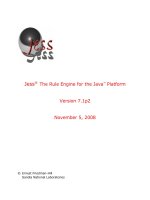Tài liệu Negotiate the Best Lease For Your Business pdf
Bạn đang xem bản rút gọn của tài liệu. Xem và tải ngay bản đầy đủ của tài liệu tại đây (1.66 MB, 408 trang )
Negotiate the
Best Lease For
Your Business
by Attorneys Janet Portman and Fred S. Steingold
2nd edition
Nolo’s Legal Updater
We’ll send you an email whenever a new edition of your book
is published! Sign up at www.nolo.com/legalupdater
.
Updates @ Nolo.com
Check www.nolo.com/updates to fi nd recent changes
in the law that aff ect the current edition of your book.
Nolo Customer Service
To make sure that this edition of the book is the most
recent one, call us at
800-728-3555 and ask one of
our friendly customer service representatives.
Or fi nd out at www.nolo.com
.
e law changes, but Nolo is always on top of it! We off er several
ways to make sure you and your Nolo products are always up to date:
NOLO
always up to date
2
1
3
We believe accurate and current legal information should help you solve
many of your own legal problems on a cost-effi cient basis. But this text
is not a substitute for personalized advice from a knowledgeable lawyer.
If you want the help of a trained professional, consult an attorney
licensed to practice in your state.
NOLO
please note
Negotiate the
Best Lease For
Your Business
by Attorneys Janet Portman and Fred S. Steingold
2nd edition
Second Edition JULY 2005
Editor MARCIA STEWART
Illustrations LINDA ALLISON
Cover Design TONI IHARA
Book Design TERRI HEARSH
Production SARAH HINMAN
Proofreading EMILY K. WOLMAN
Index THÉRÈSE SHERE
Printing CONSOLIDATED PRINTERS, INC.
Steingold, Fred.
Negotiate the best lease for your business / by Fred S. Steingold and Janet Portman.
2nd ed.
p. cm.
Rev. ed. of: Leasing space for your small business/ by Janet Portman and Fred S.
Steingold. 1st ed. 2001.
Includes index.
ISBN 1-4133-0216-5
1. Commercial Leases. 2. Office leases. 3. Small Business Management. I. Portman,
Janet II. Portman, Janet. Leasing space for your small business. III. Title.
HD1393.25P67 2005
658.15’242 dc22
200540536
Copyright © 2001 and 2005 by Nolo
and Fred S. Steingold
ALL RIGHTS RESERVED. Printed in the U.S.A.
No part of this publication may be reproduced, stored in a retrieval system or transmitted in any form
or by any means, electronic, mechanical, photocopying, recording or otherwise without prior written
permission.
Reproduction prohibitions do not apply to the forms contained in this product when reproduced for
personal use.
For information on bulk purchases or corporate premium sales, please contact the Special Sales
Department. For academic sales or textbook adoptions, ask for Academic Sales. Call 800-955-4775 or
write to Nolo, 950 Parker Street, Berkeley, CA 94710.
Acknowledgments
We couldn’t have written this book without the assistance and support of many
people.
We’d like to thank Jake Warner, Nolo’s founder and executive publisher, for his
conviction that we could write this book—and patience while we did it. To the extent
that readers find the text clear and to the point, credit goes to our meticulous editor,
Marcia Stewart, who can spot a mushy sentence a mile away and fix it in a trice.
Others at Nolo who helped include:
Stan Jacobsen, who provided valuable research assistance
Tamara Traeder, who offered useful editorial advice
Terri Hearsh, who designed the book and threw in a little editing, gratis, and
Mike Mansel, of Argo Insurance Group in Pleasanton, California, who is technically
not a Noloid but whose generous help on insurance issues over the years makes him
part of the family.
Thanks go also to the Practicing Law Institute, whose programs and materials on
commercial leasing were invaluable.
Table of Contents
Introduction
A. How Leases Are Made and What They Look Like I/2
B. How This Book Can Help You Negotiate a Favorable Lease I/3
Part I:
Finding and Evaluating Space and
Developing a Negotiation Strategy
1
What Kind of Space Do You Need?
A. Do You Need to Move Now? 1/4
B. Setting Your Priorities 1/9
C. Rent, Deposits, and Improvements 1/10
D. Location 1/11
E. Length of the Lease and When It Begins 1/13
F. Size and Physical Features 1/16
G. Other Tenants and Services in and Near the Building 1/20
H. Parking 1/21
I. Building Security 1/21
J. Image and Maintenance 1/22
K. Expansion or Purchase Potential 1/23
L. Preparing Your Rental Priorities Worksheet 1/26
M. Subleasing Space 1/26
2
Looking for Space and Using Brokers
A. How to Find Space on Your Own 2/3
B. Working With a Real Estate Broker 2/7
C. The Value of Hiring Your Own Broker 2/12
D. How to Find a Real Estate Broker 2/13
E. How to Choose a Broker 2/14
F. Signing a Contract With Your Broker 2/16
G. Handling Problems With Your Broker 2/21
3
Evaluating the Space and the Landlord
A. Visiting and Evaluating Prospective Space 3/3
B. Further Investigation of Promising Space 3/8
C. Environmental Issues to Consider When Evaluating Space 3/12
D. Learning About the Landlord 3/18
E. Management Companies 3/24
F. Holding the Space With a Deposit 3/24
4
Understanding the True Size and Cost of the Rental
A. How Landlords Measure Square Feet 4/3
B. Additional Rent: Gross Versus Net Leases 4/10
C. Percentage Rent—Sharing Income With the Landlord 4/13
D. Computing the True Rental Cost 4/15
5
Setting the Stage to Negotiate
A. How Much Clout Do You Have? 5/4
B. Your Landlord’s Compliance With the Executive Order on Terrorism 5/12
C. Getting Past Deal Breakers 5/14
D. Letter of Intent 5/18
E. Finding and Paying for a Lawyer 5/27
6
Your Negotiation Strategy
A. Your Negotiation Strategy Worksheet 6/4
B. How to Use Your Negotiation Strategy Worksheet 6/12
C. How Your Lawyer Can Help With Negotiations 6/20
D. How to Modify the Landlord’s Lease 6/25
Part II:
Common Lease Terms
7
Lease Basics
A. Naming the Landlord and Tenant: Parties to the Lease 7/3
B. Describing the Leased Space 7/6
C. The Use Clause and Exclusive Clause 7/9
8
The Length of Your Lease
A. When Do Your Legal Responsibilities Begin and End? 8/2
B. The Crafty Use of “As of” [Date] 8/5
C. How to Keep Track of Dates With a Timeline 8/6
D. Staying After the Term Ends: Holdover Rent 8/7
9
Rent
A. Basic Rent 9/3
B. Taxes As Additional Rent 9/8
C. Insurance As Additional Rent 9/14
D. Operating and Common Area Maintenance Costs
As Additional Rent 9/24
E. Audit Rights 9/29
10
Security Deposits
A. Where the Landlord Will Keep the Deposit 10/2
B. How the Landlord Will Use the Deposit 10/3
C. When the Landlord May Use the Deposit 10/4
D. The Fate of the Deposit at the End of the Lease 10/5
E. Letter of Credit: An Alternative to a Cash Deposit 10/6
11
Improvements and Alterations
A. Improvements Versus Trade Fixtures 11/3
B. Renting Space in a Building Under Construction 11/6
C. Improvements to Your Space 11/7
D. Paying for the Improvements 11/11
E. The Tenant Improvement Allowance (TIA) 11/14
F. The Building Standard Allowance, or “Build-Out” 11/16
G. Paying a Fixed Amount for Improvements 11/17
H. The Landlord Pays for All Improvements 11/17
I. When Do You Start Paying Rent? 11/18
J. Making Alterations During Your Tenancy 11/22
12
Maintenance, Utilities, and Code Compliance
A. Maintenance, Repairs, and Janitorial Services 12/2
B. Utilities 12/6
C. Compliance With Building Codes and Other Laws 12/9
D. Compliance With the Americans With Disabilities Act (ADA) 12/13
13
Parking, Signs, Landlord’s Entry, and Security
A. Parking 13/2
B. Hours of Operation 13/3
C. Signs 13/4
D. Landlord’s Right to Enter Your Rental Space 13/5
E. Building Security 13/7
14
Option to Renew or Sublet and Other Flexibility Clause
A. Restrictions on Your Flexibility 14/3
B. Option to Renew the Lease 14/5
C. Option to Expand Clause 14/8
D. Rights of First Refusal and First Offer 14/11
E. Option to Lease Less 14/13
F. The Assignment and Sublet Clause 14/16
G. Termination Clause 14/28
H. Option to Purchase 14/33
15
Insurance Clauses
A. Property and Liability Insurance 15/2
B. Insuring Your Trade Fixtures and Inventory 15/2
C. Rental Interruption Insurance 15/3
D. Business Interruption Insurance 15/4
E. Leasehold Insurance 15/5
F. Waivers of Subrogation Rights 15/5
G. Indemnity or Hold Harmless Clause 15/7
16
Breaking the Lease, Disputes, and Attorney Fees
A. The Landlord’s Remedies If You Fail to Pay Rent or
Breach Another Lease Term 16/2
B. The “No Waiver” Clause 16/7
C. Your Remedies If the Landlord Breaches 16/9
D. Mediation and Arbitration 16/11
E. Attorney Fees 16/15
17
Foreclosures, Condemnations, Guarantors, and
Other Clauses
A. Subordination and Attornment 17/3
B. Estoppel Certificates 17/10
C. The Condemnation Clause 17/12
D. Surrender Clause 17/17
E. The “Entire Agreement” Clause 17/19
F. The “Severability” or “Survival” Clause 17/20
G. Lease Guarantors 17/20
H. Signatures 17/23
Index
Introduction: Using This Book to Negotiate
Your Commercial Lease
A. How Leases Are Made and What They Look Like I/2
1. There Are No “Standard” Leases I/2
2. How Leases Are Organized I/3
B. How This Book Can Help You Negotiate a Favorable Lease I/3
I/2 NEGOTIATE THE BEST LEASE FOR YOUR BUSINESS
Y
our business has been a success
and you are ready to move into a
better place. You have decided to
streamline your operations and rent a more
efficient space. Your home business is
bursting out of the garage and definitely
needs its own location. Negotiate the Best
Lease for Your Business is a useful guide
that can help both the person considering a
commercial lease for the first time, as well
as the person who has been down this path
before and would like to negotiate a more
favorable lease for his or her business. It’s
helpful for all types of businesses—from re-
tail stores in strip malls to one-person con-
sulting firms downtown to small
manufacturing firms.
A. How Leases Are Made and
What They Look Like
The lease that you and your landlord sign
defines your legal relationship. It’s a con-
tract in which:
• you agree to pay rent and abide by
other conditions (such as using the
space for a consulting business only
or not displaying outside signs unless
the landlord first approves them), and
• your landlord agrees to let your busi-
ness occupy the space for a set
amount of time, perhaps with a num-
ber of listed amenities such as on-site
parking and weekly janitorial service.
Along with your insurance policy and
your loan documents, your lease will be
one of the most important legal documents
in your filing cabinet.
Typically, you’ll be working with a lease
form that’s been written by the landlord or
the landlord’s lawyer—and you can bet that
neither one of them will be looking out for
your best legal or business interests. You
need this book to even the playing field, so
that the landlord’s proposed lease is just
the starting point from which you’ll negoti-
ate changes.
1. There Are No “Standard” Leases
Contrary to what a landlord may have you
believe, there is no such thing as a “stan-
dard” lease. (That’s why this book does not
include a lease agreement.) Unlike other
aspects of business, there are surprisingly
few legal constraints on what tenants and
landlords agree to do. Even if the landlord
starts with a form that’s widely used in your
community, printed and distributed by a
big real estate management firm, or ac-
cepted by other tenants who lease from this
landlord, it can always be modified. The
only constraints on your landlord’s ability
to negotiate come from preexisting prom-
ises to other tenants in the building, and
obligations to lenders or insurers.
Commercial leases can and should reflect
the give-and-take between the landlord and
tenant—one size simply doesn’t fit all. No
matter how official-looking the document
that comes out of the landlord’s or broker’s
briefcase, keep in mind that it’s negotiable.
WHAT KIND OF SPACE DO YOU NEED? I/3
Just how negotiable depends on decidedly
nonlegal issues such as how tight the mar-
ket is for your desired space, how badly
the landlord wants to rent the space to you,
and how badly you want it. Within the
range of negotiability, however, your
knowledge of what you want out of your
lease space, and your understanding of the
meaning and interrelatedness of lease
clauses will determine the success of the
lease negotiation.
2. How Leases Are Organized
Leases are usually organized by numbered
paragraphs or clauses. Often, the Arabic or
Roman number is followed by a title (such
as “II. Term”), but the title may not alert
you to what the clause covers (consider
“III: Subordination”). To compound mat-
ters, lawyers often dress the body of these
clauses in dense legal verbiage or burden
them with mile-long sentences. The chart
below, “Common Major Lease Clauses,”
may help you match a clause title to its
subject matter, and it steers you to the
appropriate place in this book where we
discuss the clause, explain how it will affect
your business, and suggest negotiating
strategies for modifying it.
B. How This Book Can Help
You Negotiate a Favorable
Lease
This book is divided into two major sec-
tions. Part I helps you think through the
type of space most appropriate for your
business. All businesses have some com-
mon concerns regarding rental space, such
as cost, responsibility for improvements, air
quality, and safety, but different types of
business have differing priorities—the retail
store manager is concerned about parking,
foot traffic, and personality of the neighbor-
hood; the startup business owner may be
thinking primarily about cost and the
manufacturing business operator will be
thinking about loading docks and access to
highways. Part I will help you develop not
only your list of “must have” characteristics
for your particular commercial space, but
also a negotiating strategy to achieve them
at the best terms possible. While this book
may not be appropriate for someone devel-
oping a highly complex chemical facility, it
will help most business owners and manag-
ers think about the general needs of their
businesses, and the specific space charac-
teristics that will serve those needs.
If you already know exactly want you
want in your space and in your lease, go
directly to Part II, Common Lease Terms
(Chapters 7 through 17). “Common Major
Lease Clauses,” shown at the end of this
I/4 NEGOTIATE THE BEST LEASE FOR YOUR BUSINESS
introduction, will give you a quick
roadmap to the dozens of specific clauses
covered in the second part of the book.
Chapters 7 through 17 address specific
lease provisions, their legal meaning, how
they will affect your business, and how to
change a particular clause to get what you
want out of your lease. The types of lease
terms covered in these chapters include
rent, security deposits, improvements and
alterations, maintenance, parking, renewal
options, and other provisions common to
most leases, such as restrictions on use of
the premises and the landlord’s right to ter-
minate the lease.
Reading this book will help you under-
stand the dense, incomprehensible lan-
guage of most commercial leases, what
dangerous terms you should avoid, what
tenant-friendly terms to press for, and what
clauses you can live with. You’ll find all the
information and strategies you need to ne-
gotiate with an experienced landlord. This
practical guide also suggests ways that you
can work cost-effectively with an experi-
enced real estate lawyer, broker, and other
professionals as you negotiate your lease.
Guide to Icons Used in This Book
Reference or further reading: This
icon lets you know where you can
read more about the particular issue or
topic discussed in the text.
This icon means that you may be
able to skip some material that
doesn’t apply to your situation.
This icon alerts you to a practical
tip or good idea.
This is a caution to slow down and
consider potential problems you
may encounter.
WHAT KIND OF SPACE DO YOU NEED? I/5
Common Major Lease Clauses
Clause name What it’s about Where it’s discussed
Parties or
Lessor and Lessee or
Landlord and Tenant The names of the landlord and tenant Ch. 7, Sec. B
Premises A description of the space you’re renting Ch. 7
Rent Explains how the rent is calculated Chs. 4 & 9
Term When the lease begins and how long it
will run Ch. 8
Deposit The security deposit demanded by the landlord Ch. 10
Hold Over What happens if you don’t move out as
planned at the end of your lease Ch. 8, Sec. D
Use Restrictions and requirements on how you
use your rented space Ch. 7, Sec. D
Utilities Explains how utilities are metered and
how costs are apportioned Ch. 12, Sec. B
Taxes Describes which taxes you will have to
pay for, and how much Ch. 9, Sec. B
Insurance & Covers which insurance policies you must
Indemnity take out or pay for Ch. 9, Sec. C; Ch. 15
Security Covers the building security and who
pays for it Ch. 13, Sec. E
Parking Describes available parking and how it’s
paid for Ch. 13, Sec. A
Maintenance Covers the common area maintenance
(CAM) costs you have to pay for Ch. 12
Alterations & Explains which alterations you may
Repairs make and whether you need permission;
delegates repair duties Ch. 11
I/6 NEGOTIATE THE BEST LEASE FOR YOUR BUSINESS
■
Common Major Lease Clauses (continued)
Clause name What it’s about Where it’s discussed
Assignment & Describes the conditions under which you
Subletting can turn space over to another tenant Ch. 14, Sec. F
Options Covers your rights to extend, expand, or
contract the amount of space you rent or
the lease term. May also cover your right
to buy the property Ch. 14, Secs. B–E
Defaults & Remedies Explains what happens if you or the landlord
fails to live up to the lease Ch. 16
Destruction Covers what will happen if all or part of
the building is destroyed Ch. 14, Sec. G
Condemnation Describes what happens to your lease if
the building is condemned by a government
entity Ch. 17, Sec. C
Subordination, Financing clauses covering what happens
Nondisturbance, if your landlord’s lender forecloses on a
& Attornment loan that’s secured by the building Ch. 17, Sec. A
Estoppel Explains your duty to provide a signed
statement that you and the landlord are
complying with the lease terms Ch. 17, Sec. B
Attorney Fees Your agreement as to who pays the
winner’s fees and costs if a disagreement
ends in litigation Ch. 16, Sec. E
Guaranty Your promise that you will provide someone
who will guarantee your financial duties
under the lease. The guarantor must also
sign the lease Ch. 17, Sec.G
Dispute Resolution The mechanism for settling disputes, short
of resorting to a lawsuit Ch. 16, Sec. D
Part I:
Finding and Evaluating Space and
Developing a Negotiation Strategy
Chapter 1
What Kind of Space Do You Need?
A. Do You Need to Move Now? 1/4
1. Working From Home 1/4
2. Staying in Your Current Rental 1/6
3. Buying Instead of Renting 1/7
B. Setting Your Priorities 1/9
C. Rent, Deposits, and Improvements 1/10
1. Rent 1/10
2. Deposits 1/10
3. Other Improvements and Expenses 1/11
D. Location 1/11
1. Neighborhood and Neighbors 1/11
2. Commuting Time 1/13
3. Access to Public Transportation 1/13
4. Expressways, Freeways, and Throughways 1/13
E. Length of the Lease and When It Begins 1/13
1. Length of the Lease 1/14
2. Move-In Date 1/16
F. Size and Physical Features 1/16
1. Size of Space 1/16
2. Interior Needs 1/17
3. Soundproofing 1/18
1/2 NEGOTIATE THE BEST LEASE FOR YOUR BUSINESS
4. Operating Windows 1/18
5. Control of Heating and Cooling 1/19
6. Storage Space 1/19
7. Private Restrooms 1/19
8. Technological Capacities 1/19
G. Other Tenants and Services in and Near the Building 1/20
H. Parking 1/21
I. Building Security 1/21
J. Image and Maintenance 1/22
1. Image 1/22
2. Maintenance 1/22
3. Nonsmoking Policy 1/22
4. Visibility and Signage 1/23
5. Special Requirements 1/23
K. Expansion or Purchase Potential 1/23
1. Ability to Expand Space 1/23
2. Potential Purchase 1/23
L. Preparing Your Rental Priorities Worksheet 1/26
M. Subleasing Space 1/26
WHAT KIND OF SPACE DO YOU NEED? 1/3
Read This Chapter If …
This chapter is for those of you who are
considering a move, evaluating a likely
rental, or thinking about subletting. It’s es-
pecially useful in the following situations:
• You’re a newcomer to the game of
commercial leasing, and need basic
information such as how landlords
measure space.
• You’d like some tips on how to evalu-
ate space, particularly whether it fits
your needs.
• You’re interested in expansion or pur-
chase rights in your lease.
• You’d like guidance on how to sys-
tematically arrive at your rental priori-
ties, which can form the basis for your
lease negotiation strategy.
You can skip this chapter
if you’re an old hand at
commercial leasing and understand
space measurement, or you’ve al-
ready picked out your rental and
need information on negotiating the
lease.
Y
our business needs should shape
your search for commercial space.
Rent will be an obvious consider-
ation, as will the building’s location, and
the size of the space. But for most small
businesses, finding the right space involves
considering more than price, location, and
size. Parking, the ease of making improve-
ments, the types of nearby complementary
and competing businesses, and numerous
other factors, such as the building’s image
and potential for expansion, may affect
your choice of a rental space.
Depending on your requirements, the
number of rentals that will satisfy them will,
naturally, shrink.
EXAMPLE: John’s company, Hi Fives,
manufactures sports equipment. He’ll
need space with a loading dock and
floors strong enough to support his
equipment. The image of the neighbor-
hood isn’t much of a factor, nor is the
makeup of nearby businesses.
EXAMPLE: Mary’s business, a children’s
clothing store, will do best if it’s near
other retail establishments, preferably
those that parents are likely to fre-
quent. She’s on the lookout for wel-
coming, ground-level space, with lots
of windows and light.
Forces beyond your control may further
limit your choices. The availability of com-
mercial space will depend in large part on
current market conditions. Sometimes the
vacancy rate is high, meaning you’ll have a
good selection of rental spaces and relatively
low rents. Other times the vacancy rate is
low, meaning you’ll have fewer choices
and higher rents. But regardless of your
requirements or market conditions, you can
almost always locate suitable space if
you’re willing to invest some time and
effort into the process.









